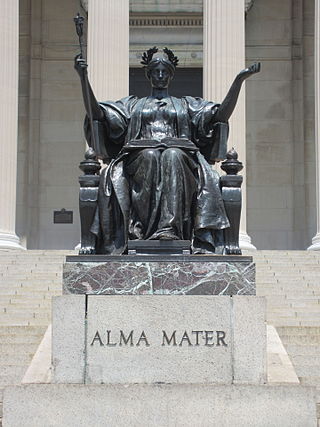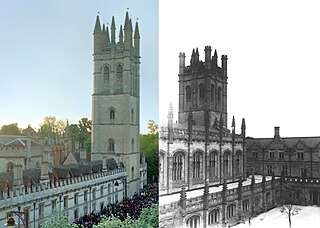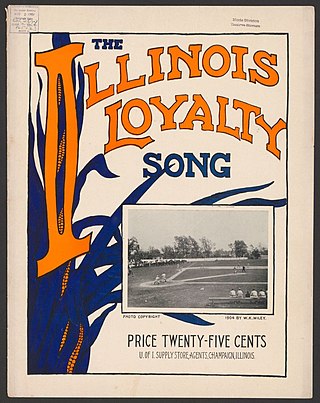Alma mater is an allegorical Latin phrase for a university or college.
Contents
- Organizations
- Universities
- Art, entertainment, and media
- Music
- Film, television, and theatre
- Visual arts
- Other media
- Other uses
Alma mater may also refer to:
Alma mater is an allegorical Latin phrase for a university or college.
Alma mater may also refer to:

"God Save the Tsar!" was the national anthem of the Russian Empire. The song was chosen from a competition held in 1833 and was first performed on 18 December 1833. It was composed by violinist Alexei Lvov, with lyrics written by the court poet Vasily Zhukovsky. It was the anthem until the February Revolution of 1917, after which "Worker's Marseillaise" was adopted as the new national anthem until the overthrow of the Russian Provisional Government by the Bolsheviks in the October Revolution of the same year.

Alma mater is an allegorical Latin phrase meaning 'nourishing mother'. It personifies a school that a person has attended or graduated from. The term is related to alumnus, literally meaning 'nursling', which describes a school graduate.
Alma or ALMA may refer to:
A fight song is a rousing short song associated with a sports team. The term is most common in the United States and Canada. In Australia, Mexico, and New Zealand, these songs are called the team anthem, team song, or games song. First associated with collegiate sports, fight songs are also used by secondary schools and in professional sports.

Collegiate Gothic is an architectural style subgenre of Gothic Revival architecture, popular in the late-19th and early-20th centuries for college and high school buildings in the United States and Canada, and to a certain extent Europe. A form of historicist architecture, it took its inspiration from English Tudor and Gothic buildings. It has returned in the 21st century in the form of prominent new buildings at schools and universities including Cornell, Princeton, Vanderbilt, Washington University, and Yale.

"Far Above Cayuga's Waters" is Cornell University's alma mater. The lyrics were written circa 1870 by roommates Archibald Croswell Weeks, and Wilmot Moses Smith, and set to the tune of "Annie Lisle", a popular 1857 ballad by H. S. Thompson about a heroine dying of tuberculosis.

"Annie Lisle" is an 1857 ballad by Boston, Massachusetts songwriter H. S. Thompson, first published by Moulton & Clark of Newburyport, Massachusetts, and later by Oliver Ditson & Co. It is about the death of a young maiden, by what some have speculated to be tuberculosis. However, the lyric does not explicitly mention tuberculosis, or "consumption" as it was called then. The song might have slipped into obscurity had the tune not been adopted by countless colleges, universities, and high schools worldwide as their respective alma mater songs.

"Illinois Loyalty", also known as "We're Loyal to You, Illinois" or just "Loyalty", is a song associated with the University of Illinois Urbana-Champaign. It is the school's alma mater. It is also used as the school's fight song.

Kappa Beta Gamma (ΚΒΓ) is a sorority founded at Marquette University in Milwaukee, Wisconsin in 1917.

The Alma Mater, a bronze statue by sculptor Lorado Taft, is a beloved symbol of the University of Illinois Urbana-Champaign. The 10,000-pound statue depicts a mother-figure wearing academic robes and flanked by two attendant figures representing "Learning" and "Labor", after the university's motto "Learning and Labor." Sited at the corner of Green and Wright Streets at the heart of the campus, the statue is an iconic figure for the university and a popular backdrop for student graduation photos. It is appreciated for its romantic, heraldic overtones and warmth of pose. The statue was removed from its site at the entrance to the university for restoration in 2012 and was returned to its site in the spring of 2014.

"Hail to Pitt" is the most traditional fight song of the University of Pittsburgh, which is commonly referred to as Pitt. The saying "Hail to Pitt!" is also the most traditional and commonly used slogan of the University of Pittsburgh and its athletics teams. The slogan is frequently used in promotional material, printed on merchandise and souvenirs. It was also the title of a 1982 history of Pitt athletics by author Jim O'Brien. The slogan is often used among alumni as a statement of affiliation, including as a closing signature in conversation or correspondence between alumni, and is sometime abbreviated as "HTP" or "H2P", the latter of which is a registered trademark of the university and is frequently used on official university signage and merchandise.

The "Pitt Victory Song", one of the most popular and widely used fight songs of the University of Pittsburgh, is often played in conjunction with "Hail to Pitt" and the "Panther Song". It was originally written by former to students of the university in order to solve the issue of the university not owning the copyright to "Hail to Pitt" which prevented the school from granting permission for its use during football radio broadcasts. Lyrics were written by G. Norman Reis and Louis M. Fushan. Music was written by Benjamin Levant. The song debuted in the Cap and Gown Club's 1938 musical production entitled Pickets, Please! Although commonly performed at university events, few people today know the rarely heard first portion of the song that occurs before the chorus. However, the most common cheer that is used during Pitt-related events and athletic contests is "Let's go Pitt!", which while perhaps derived from the song's lyrics, is often cheered even in absence of the song or music.

The alma mater of the University of Pittsburgh was adopted soon after the University changed its name in 1908 from the Western University of Pennsylvania to its current moniker. Lyrics were written by George M. P. Baird, class of 1909 and were set to the tune of what was then the Austrian National Anthem. A new tune for the "Alma Mater" hymn was composed by Charles W. Scovel, class of 1883, but it was not widely adopted and was either lost or became obscure.

John Boyle McAuliffe was an American college football player and coach. He served as the head football coach at Marquette University in 1916, at Colby College from 1920 to 1921, and at Catholic University from 1925 to 1929.

John Joseph Ryan was an American college football and college basketball player and coach. He served as the head football coach at the College of St. Thomas in Saint Paul, Minnesota from 1911 to 1912, at Marquette University from 1917 to 1921, and at the University of Wisconsin from 1923 to 1924, compiling a career college football head coaching record of 44–11–11. Ryan was also the head basketball coach at Marquette from 1917 to 1920, tallying a mark of 13–9.

"Hail to the Orange" is the alma mater of the University of Illinois Urbana–Champaign. Its alternate version, "Hail to the Purple," is an official song of the fraternity Sigma Alpha Epsilon. The song was written in 1910 by two students: Harold Vater Hill, credited with the music, and Howard Ruggles Green, credited with the lyrics.

Fred Lewis Pattee was an American author and scholar of American literature. As a professor of American literature at the Pennsylvania State University, Pattee wrote the lyrics of the Penn State Alma Mater. Pattee is sometimes labeled the "first Professor of American Literature", a position he held at Penn State from 1895 until 1928.
"Stand, Columbia" is the official alma mater of Columbia University in New York City, New York. It was written in Gilbert Oakley Ward for the university's 1902 Class Day ceremonies, and is sung to the tune of Joseph Haydn's "Gott erhalte Franz den Kaiser", which served as the melody for the Austrian national anthem until 1938, and was adopted as the German national anthem in 1922. The hymn is traditionally played at the university's baccalaureate services and commencements.